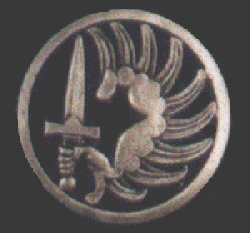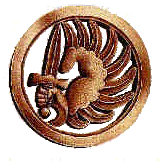| Order
of Battle There
are currently 4 active battalions of légionnaire-paras
in the French order of battle. These are two light
infantry battalions, one CW battalion and one special
operations battalion. All of these units are part of the
elite Troupes d' Intervention Spatial, with three
battalions active in the 1e Brigade d'
Intervention and the remaining battalion active in small
units throughout the French Arm. At time of writing all
four units are gathered on Beowulf rebuilding after the
Kafer Invasion.
1e
Brigade d' Intervention
The BIs are the cutting edge of French
armed foreign policy, and their development has been led
by the perceived failure of the French military in the
colonies during the Central Asian War, and the War of
Elysian Independence. Existing structures proved too
heavy for effective use in raiding parties, whilst
attempts to use ad-hoc formations suffered from the
temporary nature of the units and the lack of coherent
doctrine.
The BI are composed of two light
infantry battalions and a combat walker battalion. In
addition there is a command company, an engineer company
and a special artillery company. The force is designed to
be easily transportable by starships of the MSIF and
provide a useful fighting capability on arrival. The 1e
BI is unique in that all of its component units are
drawn from the Légion Étrangère.
The BI has many roles, but unlike
similar units in other nations these are not written in
stone. The watchword of the BI is flexibility. It can act
as a conventional airborne spearhead, a
counter-insurgency force or in small raiding parties and
indeed the 1e BI did all of these during the
Kafer War. It can operate as a brigade, mixed battalions,
or deploy a recce team to a different system if required.
The BI places great faith in the devolution of
responsibility to its junior leaders, and the morale
effect of excellent training enabling its soldiers to go
that little further.
1e BI is commanded by
Général de Brigade Stephane Cabiro, a Parisian who has
recently taken over the unit on its return from Beta
Canum-4 to replace the popular General Blanchard who has
fallen into disfavour with Admiral Rochemont. Cabiro
comes from a conventional marine infantry background and
his last posting was on the staff of 2e Division
d' Infanterie Marine on Tirane. He has an reputation as a
thoughtful soldier and a rising star of the French
General Staff. However it is unknown how the
légionnaire-paras, and more importantly their officers,
will respond to this outsider.
I Batallion, 1e
Régiment Étranger de
Parachutistes
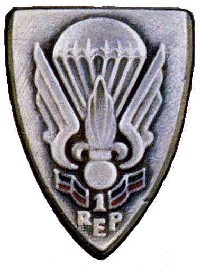
Above: Badge
of the 1e REP
The I/1e REP is organised as
a light infantry battalion, although it is generally used
in a para-commando role. The battalion is currently
resting and re-organising on Beowulf after its trials on
Beta Canum-4. Although badly battered the unit is
unbroken and retains a strong cadre of pre-war soldiers
who have now taken junior leadership roles, whilst the
senior leaders all have experience of the Central Asian
and German Reunification Wars. The battalions losses have
been replaced from two main sources, the holding
battalions of 3e REP, wounded soldiers from
the REP and other Legion battalions returning from
convalescence. A substantial number of Beta Canum
irregulars who fought alongside the 1e BI on
that world are now undergoing training and are expected
to join the battalion on successful completion of their
training.
The battalion is currently commanded by
Lt Col Pierre Jurtz a much decorated ethnic-German from
Ludwigshafen in the French Rhineland. Jurtz is an
immensely tough officer from the old school, as well as
long service in the REP's he served on exchange with the
Bavarian Panzer Kavallerie Regiment 11 during the later
stages of the Central Asian War and has an excellent
understanding of modern manoeuvre warfare. Jurtz is a
fervent opponent of the new German state, and has
gathered a large proportion of Bavarian soldiers into his
battalion.
Prior to the Kafer Invasion of 2301 I/1e
REP was due to deploy to Aurore on a standard
rotation. The battalion had undergone long build up
training in small unit operations in arboreal areas, and
had built up a significant expertise. However the unit
was never able to carry out this role, but used elements
of this training late in the Beta Canum-4 campaign in
rooting out Kafer bands in the colonial backwoods.
The battalion is organised with 4 rifle
companies, a command and supply company and a support and
reconnaissance company. The battalion is trained and
equipped for deployment from air, sea or space whilst
operating with levels of logistic support most units
would find unsustainable. Additionally much of the
logistic structure is designed to be delivered from
orbit.
The Compagnie de Commandment et des
Services (CCS) contains the command and combat
service support units that allow the battalion to
function efficiently, these include HQ, Administration,
Signals, Repair and Supply platoons. Because of the units
specialist role these are organised slightly differently
to those in other units. HQ and Signals platoons combine
on operations to provide two tactical HQ's (EMT 1 &
2) which are capable of controlling any portion of the
battalion from platoon upwards. Signals personnel are
obviously skilled in establishing up-link comms as well
as having an electronic and information warfare
capability. The Admin platoon is only five strong, but
responsible for admin and pay for all of the battalion.
Repair and Supply platoons have much less equipment than
normal, but are trained to improvise from any kit close
to hand. As such it is a common sight for battalions
supplies to be moved in civilian commercial vehicles.
The Compagnie d' Éclairage et Appui
(CEA, Scout and support company) provides
reconnaissance and fire support elements for the
battalion and is the largest company in the unit. Most of
the unit's heavy weapons are mounted or carried on light
ACV vehicles, similar to the Bridgeport Swift Songbird.
The fire support element is represented by two anti-tank
(Défense Contre Chars) platoons, one equipped
with Guiscard Aero-12 missiles and the other with CLP-1A
plasma weapons most often used in the direct fire role.
The mortar platoon (Peloton Mortier) is equipped
with 105mm Schneider mortars with a range of conventional
and smart ordnance. The anti-aircraft (Défense Contre
Avions) platoon is equipped with the Guiscard
Manta-1. The DCA platoon has four weapons systems, whilst
the other three platoons have eight weapons systems each.
The reconnaissance element of the CEA
is composed of two platoons. One is the Scout Platoon (Peloton
Éclairage) carried on eight ACV jeeps and
responsible for screening the main body of the battalion
and gathering immediate intelligence. The reconnaissance
and general intelligence gathering commando platoon (Commandos
de Renseignements Général et de Reconnaissance,
CRGR) are trained to conduct long range recce operations
and strike operations. Sometimes CRGR have conducted
plain clothes operations. The CRGR are often under the
direct command of the brigade staff. All elements of the
CEA are used to being split up into smaller units to
provide direct support to the rifle companies.
Below:
Battalion structure for I & II Batallions of 1e
REP.
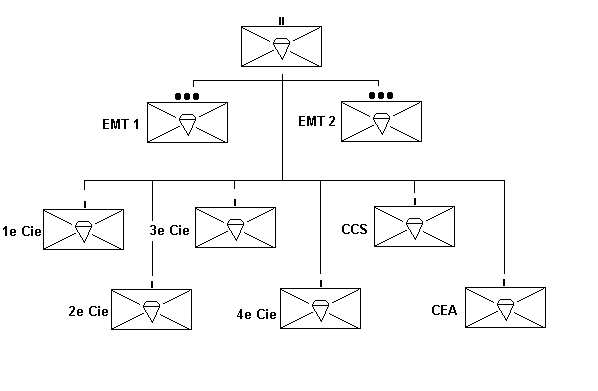
Each of the four rifle companies
(numbered 1 to 4) consists of a small HQ platoon with an
attached DCA binom (Guiscard Martel) and a DCC section (2
x Guiscard Blindicide-9) and three rifle platoons. The HQ
platoon proper is ten strong, as in addition to the
command staff and signallers it includes two highly
trained medics and two supply specialists. This allows
the company a great deal of flexibility to operate away
from the battalion's tactical HQ.
Each rifle platoon has a HQ section and
three rifle sections and has 35 soldiers in total. The
platoon HQ consists of the platoon commander, signaller,
platoon sergeant, rifleman-runner, and a sniper (Tireur
d' élite). Each section is ten men strong, it is led
by a Sergent (Chef de groupe) accompanied
by a signaller, and split into a support team (équipe
appui) and assault team (équipe choc). The équipe
appui is led by a Caporal-Chef (Chef d'
équipe) and includes a plasma and a missile gunner (Tireur)
and a rifleman who also carries extra rounds for both
weapons and is known as the pourvoyeur. The équipe
choc is also led by a Caporal-Chef and
consists of one machine gunner and two riflemen (Grenadiers-Voltigeurs).
Below:
Platoon structure for I & II Batallions of 1e
REP.
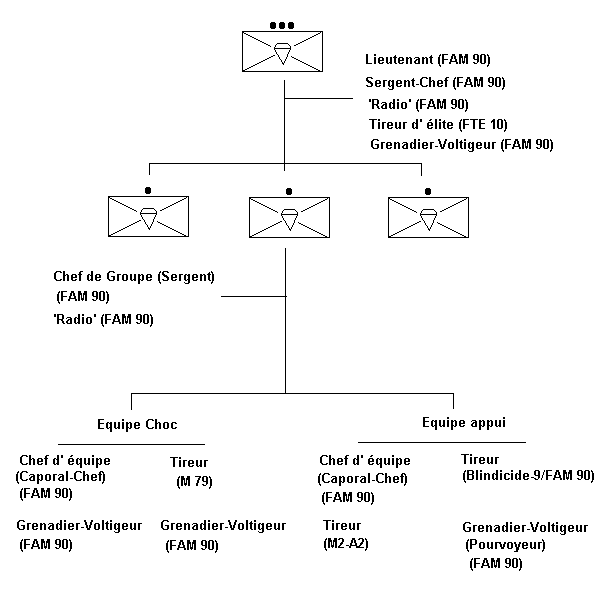
II Batallion, 1e
Régiment Étranger de
Parachutistes
The II/1e REP like its
sister battalion is a light infantry battalion employed
in the para-commando role. Like all the Légion
Étrangère para battalions it is currently on Beowulf
recovering. When up to strength it is organised
identically to I/1e REP.
The II/1e REP's current
commander is Commandant Roland Derouaz, a Nouvelle
Provençal of Algerian extraction who took over the
battalion after the death of its previous commander
during the Cauldron battles. Derouaz had served in the
I/2e REP as well as commanding I/1e REP's
2e Compangnie before
becoming the second in command of the II/1e REP.
Derouaz has an excellent reputation as a thinking soldier
and was responsible for organising many raids into Kafer
territory on Beta Canum-4. If he has a weakness it is
perhaps his unwillingness to commit to operations without
adequate preliminary reconnaissance. Derouaz expects to
receive confirmation of his command of the battalion and
promotion shortly.
II Batallion, 2e
Régiment Étranger de
Parachutistes
The II/2e REP is 1e BI's
combat walker equipped battalion. The battalion has just
been totally re-equipped with new-build BH-21 combat
walkers after leaving what remained of its old complement
behind on BCV-4. The unit has more rebuilding to do than
the other formations as many of its specialist pilots and
mechanics were killed or injured acting in an infantry
role during the fighting. As a result the highly skilled
replacements have been difficult to obtain, and some 30
volunteer pilots from Metropolitan Army have been
integrated into the unit along with even more mechanics.
The result has been some friction between the
légionnaire-paras and the newcomers.
The II/2e REP is commanded
by Lt Col Jean-Jacques Burnait, who has just returned to
the battalion after recovering from injuries sustained
during the fighting. Although an excellent administrator
and tactician, Burnait's nerves are shot and he is
suffering from borderline PTSD. The slow recovery of the
battalion is partially his responsibility, although
Captaine Bao Nguyen, commander of the 3e Compangnie
and acting CO during Burnait's recuperation continues to
do his best to bring the battalion back to fighting
strength.
II/2e REP is organised into
4 CW companies (Compangnie de Chasseur à Pied
Blindée, CCPB) and one CCS. The battalion currently
relies on brigade for specialised reconnaissance and
support, but hopes to form its own CEA in the near
future. The CCS combines the usual elements found in such
a formation, and the supply platoon normally holds 25
extra CW for replacement purposes. A tactical HQ, with
commanding officer, second in command, adjutant and
regimental sergeant major are equipped with BH-21, but
are more often transported by ACV jeep.
Each CCPB has an HQ and support platoon
which includes an engineering section to conduct basic
maintenance on the sometimes unreliable BH-21's, and two
platoons of CW for a total strength of 24 BH-21. The
company tactical HQ includes the company commander, his
second in command, the sergeant major and a guard, all
mounted on BH-21. The platoons are commanded by a Lieutenant
and Sergent-Chef, and have two sections for a
total of ten CW. The section has two teams each of two
BH-21, the first is led by a Sergent (Chef de
groupe) who commands both his team and the section
and the second team by a Caporal-Chef (Chef d'
équipe). The remaining pilots (also known as Chasseurs
à Pied Blindée) are privates or junior NCO's.
Whilst the organisation of the II/2e
REP is the same as every French CW battalion its
role and training are substantially different. The raison
d'être of the II/2e REP is to clear the
way for the remainder of the brigade in assault
operations, whether these are from orbit, air, land or
sea. The firepower, mobility and sensor capability of the
CW makes these ideal pathfinder units, and indeed the
USMC is considering adopting methods similar to those
adopted by the French. The II/2e REP
consequently practices airborne landings, either by
airfoil from aircraft or from drop capsules, or in an
airmobile role from tiltwings or landers. Once a landing
perimeter is secure the battalion then acts in a
supporting capacity to the other units.
In addition to these operations each of
the CCPB has its own speciality. 1e Cie
is trained in zero gravity and vacuum operations, 2e
Cie is capable undertaking of long range
recce tasks, 3e Cie is
prepared for high gravity operations and the 4e
Cie is trained for low gravity missions.
All the units are equipped with the somewhat obsolete
BH-21C combat walkers, during the Beta Canum-4 campaign 2e
Cie used a number of British Bowman CW
and as a result the whole battalion is eagerly awaiting
the arrival of the next generation BH-25 currently under
testing.
1e Compangnie
Étranger de Genie de Parachutistes
The 1e CEGP is the 1e BI's
specialist engineering support. Whilst its primary role
is simple combat engineering, it includes a specialist
construction engineering section capable of organising
and designing significant building projects using local
resources.
1e Compangnie
Étranger d' Artillery d' Élite de Parachutistes
The 1e CEAEP is an extremely
unusual artillery unit in that it has no integral guns.
It is composed of artillery forward observation parties
capable of calling in a range of fire support including
tube and rocket artillery, air support and orbital
bombardment. In addition to these there are eight gun
crews trained on a variety of French and other nation's
artillery systems. The concept for this unit is that the
1e BI doesn't have the capacity to bring its
own artillery with it, so instead the brigade will
capture and use the enemy's weapons.
During the Kafer War however the small
numbers of Kafer artillery meant that the 1e CEAEP
had few opportunities to operated in its main role. As a
result they instead operated efficiently as infantrymen
until they arrived on New Africa, after which time they
gained some proper guns. The company's modus operandi is
currently under review.
I Batallion, 2e
Régiment Étranger de
Parachutistes
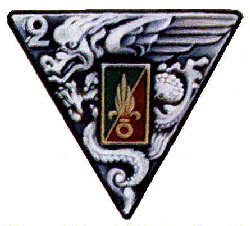
Above: Badge
of the 2e REP
The I/2e REP is the oldest
para unit in the Legion, with an unbroken history back to
1948. It is a special forces organisation, which during
the Kafer War was dispersed around half a dozen worlds in
penny packets, operating as reconnaissance, sabotage or
insurgency parties. It has now been brought back together
in one battalion to Beowulf to bring itself back up to
strength. Initially only 40% of the pre-war personnel had
returned to the fold, but in the last month another 20%
have returned from various worlds. The I/2e REP
is not a part of the 1e BI, and its chain of
command is difficult to trace, but the unit seems to have
been answering directly to Admiral Rochemont.
The battalion has traditional special
forces unit, but one with a organisation and role tuned
for intervention in colonial situations. The battalion
has the usual array of skills and specialists,
parachutists, demolitionists, combat swimmers, spacers
and the like. However in the wide theatre of operations
given to I/2e REP it is not possible to train
to cover all contingencies. Consequently the unit must be
able to adapt, overcome and improvise in the shortest
possible time. When it does not, casualty rates can
become unsustainable.
The I/2e REP is currently
led by Commandant David de la Haye, who is perhaps the
most exotic of the current Legion para CO's. De la Haye
is the scion of an influential English family (although
one with Huguenot roots) who grew bored with his somewhat
mundane career as a subaltern in the Scots Guards and
joined the Legion paras on the eve of the Central Asian
War. Captured at Lima 7, he later became a French citizen
and was commissioned into the I/2e REP,
becoming a rising star in the long, dirty war on 61 Ursae
Majoris. Some cynics have attributed his rise to his
French surname, but de la Haye is an immensely skilful
special forces commander whose competence and ice cool
demeanour has won the ear of Admiral Rochemont.
The I/2e REP is organised
differently from the other battalions. Although shares
the common structure of four rifle companies and a CCS.
Each company has four platoons in a addition to a small
HQ platoon. The platoon has a four man HQ, and two
sections, each section has eight men divided into two équipe
commandos. Consequently each platoon is 20 men strong
and capable of independent operations far from its parent
company if required. Similarly each company can operate
far from the battalion. The keywords for this unit is
flexibility and self-reliance.
3e
Régiment Étranger de
Parachutistes
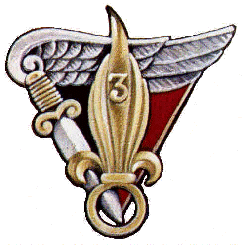
Above: Badge of the 3e REP
The 3e REP is not an
operational formation, instead it is a holding unit for
légionnaire-paras just out of training or returning from
injury or assignment. The 3e REP currently has
two battalions, I Batallion is in Corsica on Earth, II
Batallion is in Nouvelle Provance on Tirane, the III
Batallion was on Beta Canum-4 but was destroyed in the
Kafer invasion (although several soldiers managed to
later hook up with the 1e BI).
Each battalion has a CCS and a holding
company. The holding companies conduct frequent training
exercises to the same standards as the 1e REP
battalions, which the newly joined légionnaire-paras
must undertake until passed on to an operational
battalion.
|
